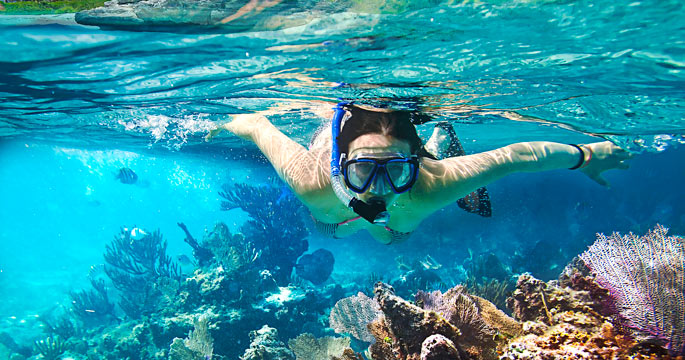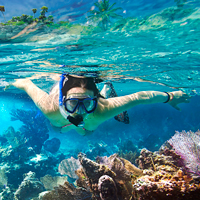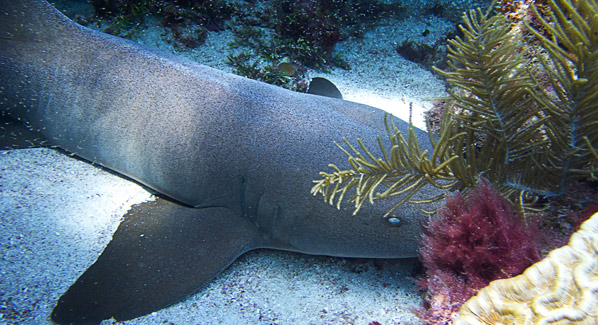Whether it’s the clear waters of the Caribbean or the blue depths of the Pacific calling, visitors to Mexico’s coast feel the call of the sea. Those who want to heed this call would do well to take a mask and snorkel, and venture out from shore. Along any coast where breaking waves don’t hinder, there are discoveries to be made. But not all snorkel sites are created equal, and these favorites offer the best combination of calm water, easy access and abundant marine life.
Cozumel
The western shores of Mexico’s Cozumel Island are home to some fantastic shallow reefs, many of which can be reached with a short swim from shore. But not all these waters are suited for novices, as the same currents that create the island’s dramatic coral and sponge growth can also make self- guided snorkeling a tricky prospect—especially at sites to the north where currents are more likely to push you out to sea than in to shore. Currents tend to be milder near the shore at sites along the central coast, and two favorite spots for shore access are the dock at the Monkey Bar Beach Club and the stone landing at the Fiesta Americana Cozumel. Boat-based tour operators have learned to use currents to their advantage, dropping groups of divers or snorkelers at one end of a reef, and then picking them up after they’ve enjoyed a free ride on the moving waters. One perennial favorite for drift snorkels is Paradise Reef, where the many nooks and crannies of the coral provide shelter for lobster, eels and more than 200 species of tropical fish. For a milder yet still memorable shore snorkel, you’ll want to head to Chankanaab Park, where you’ll find an underwater sculpture garden and swarms of colorful fish. On-island accommodations cover a wide range of options from modest to memorable, both in terms of amenities and pricing. The Cozumel Palace delivers a good combination of pampering and value.
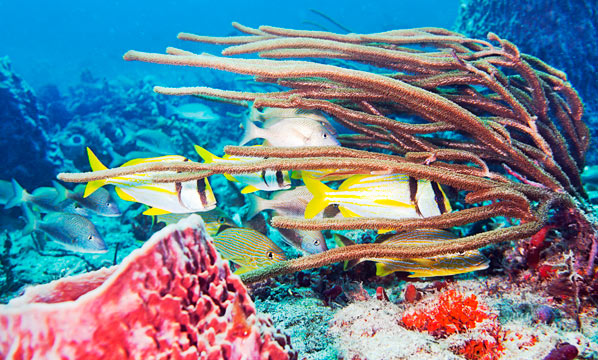
The currents that wash the reefs of Cozumel bring life-giving nutrients. Here, a school of porkfish and grunts takes shelter behind a soft coral growth. Photo: Jodi Jacobson/iStock
Cabo Pulmo
Mexico’s Cabo Pulmo National Marine Park is a haven for fish, sea lions and manta rays, and a playground for divers, sea kayakers and snorkelers, who come to explore the finest protected waters in the Sea of Cortez. It’s a two- hour drive from Cabo San Lucas to the small village of Cabo Pulmo, and several tour services provide daily transport and snorkel equipment— including the wetsuits that may be needed in the cooler months. It’s also possible to create a self-guided adventure by renting a car and driving to Mermaid’s Beach for a shore entry, or signing on with a local boat captain for a trip to Lover’s Beach or out to Frailes Rock to swim with the sea lions. In summer, water temperatures reach into the mid-80s, making wetsuits unnecessary, while sea breezes keep air temperatures significantly cooler than other parts of Baja. For those who want more than a day in the water, nearby Cabo Pulmo Beach Resort offers clean, cost-effective beach bungalows and more luxurious villas, plus an on-site dive shop and twice daily guided snorkel tours.
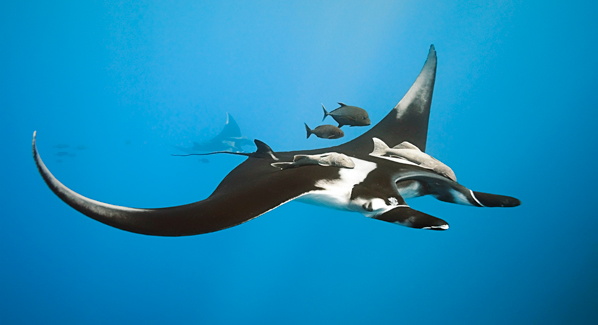
Of the more than 6,000 species of marine life found at Cabo Pulmo, manta rays are possibly the most exciting. At times, they will leap from the water. Photo: iStock
Mazatlan
The Pacific Coast city of Mazatlan overlooks a group of nearshore islands that offer plenty for snorkelers to discover. The easiest to reach, Stone Island, is actually connected to the mainland by a narrow rocky peninsula, but is best accessed by a short water taxi from South Beach across the navigation channel. Once there, the best place to fish watch is along the small rocky cove on the western tip of the island, where there are also several derelict ships sitting in shallow water. A couple of miles to the north, and directly off the resort area known as the Golden Zone, are a trio of small uninhabited islands, named Deer, Bird and Goat, which are surrounded by clear waters and shallow reefs. Tour operators offer day trips to the islands. Deer Island provides a long, shallow shelf that holds a variety of fish, while Goat Island is the least visited and offers more solitary snorkeling within a reef-sheltered basin. There are a number of prime beachfront resorts on the nearby mainland, and one of our favorites is the El Cid Marina Beach.

